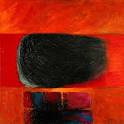Fernando de Szyszlo
Intihuatan
Source:Encyclopedia .com
The Peruvian painter and sculptor Fernando de Szyszlo was born on July 5, 1925 and died the 9 October 2017 in Lima at age of 92 years. His father was a Polish botanist, zoologist, and geographer, and his mother was a native Peruvian, sister of the Peruvian poet Abraham Valdelomar. Mario Vargas Llosa has described Szyszlo's works as among the most original representations of Latin American Art, rooted in pre-Hispanic symbols and motifs in audacious alliance with cubism, abstract art, and surrealism (Vargas Llosa, p. 9). Szyszlo studied for three years (1944–1947) with the Austrian artist Adolfo Winternitz at the School of Fine Arts at Lima's Pontificia Universidad Católica del Perú, where he then taught for twenty years (1956–1977). In 1948 he joined Espacio, a group of painters and architects who addressed nativism, seeking artistic renewal in the disciplines of indigenous pre-Hispanic cultures. Szyszlo's early paintings were figurative, but after his first trip to Europe in 1949 he turned to abstraction. He studied the lore, language, and arts of Peruvian pre-Conquest cultures, especially the Chancay culture (1200–1400 ce). He traveled to the United States in 1958 and remained in Washington, D.C., to serve as a visual arts unit consultant to the Organization of American States (1958–1960). He settled permanently in Lima in 1970.
In the 1960s Szyszlo worked on a series of thirteen paintings inspired by Quechua elegy Apu Inka Atawallpaman, on the death of Atahualpa, last ruling Inca. By the late 1960s Szyszlo had created a personal style called abstract nativism. He was artist in residence at Cornell in 1962 and a visiting lecturer at Yale University in 1966. He won the first national prize for paintings at the Esso Salon of young artists in Lima in 1964
In his abstract paintings of the 1970s he began to incorporate shapes suggestive of knives, ceremonial tables, and mummies wrapped in sacred gowns. In the 1980s he painted totemic forms in closed, three-dimensional spaces that suggest chambers. His oeuvre is mainly characterized by series of works with specific themes, most notably, in his later period, the seacoast series (the "Mar de Lurín," "Camino a Mendieta," and "Sol Negro").
Szyszlo has had a powerful influence on Peruvian painting and is the recipient of numerous honors. He became a member of the Academia Peruana de la Lengua in 1997, was named honorary professor of the Universidad de Lima in 1998, and doctor honoris causa of the Pontificia Universidad Católica del Perú in 2005. The French Ministry of Culture named him Officier de l'Ordre des Arts et des Lettres in 2001. He was awarded for the best engraving at the Feria de la Estampa in 2005 by the Asociación de Críticos de Arte de Madrid.
Fernando and his wife Liliana Yababar died together in an accident at at at home falling down the stairs.
With affection,
Ruben






